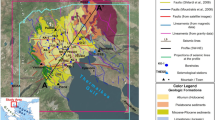Abstract
The volcanic structure of the Seymour Sewell seamount appears to have formed over a relatively long time in at least two stages. Its main massif was formed as a result of volcanic activity in the axial zone of the Central Indian Ridge about 16.3 Ma ago for about 0.5 Ma. Then the volcanic process temporarily stopped and the seamount drifted 260 km southwest along with the supporting African plate. In the last epoch of direct magnetic polarity (Brunes, 680 ka ago), as a result of a new cycle of volcanotectonic activity, the southeastern segment of the seamount collapsed. At this time, a new portion of magmatic material with a high ferrous mineral content was erupted here, reflected in the more intense magnetic anomaly confined to this part of the seamount.










Similar content being viewed by others
REFERENCES
I. A. Veklich, A. N. Ivanenko, and O. V. Levchenko, “Anomalous magnetic field ΔTa in the equatorial part of the Indian Ocean (field measurements),” Vestn. KRAUNTs. Nauki o Zemle, No. 45, 17–37 (2020).
A. M. Gorodnitskii, Structure of Oceanic Lithosphere and Formation of Underwater Mountains (Nauka, Moscow, 1985) [in Russian].
A. N. Ivanenko, “Simulation of the Magnetic Field of Underwater Mountains,” in Magnetic Field of the Ocean, Ed. by A. M. Gorodnitskii (Nauka, Moscow, 1993) [in Russian].
G. I. Kalyaev, V. N. Syrskii, A. Ya. Nasirov, and A. I. Avdeev, Main Features of the Relief and Tectonics of the Arabian-Indian Ridge (Inst. Geolog. Nauk AN USSR, Kiev, 1979) [in Russian].
O. V. Levchenko, R. A. Ananyev, I. A. Veklich, et al., “Multidisciplinary studies of the underwater mountains in the bottom of the northern segment of the Eastern-Indian Ridge,” Vestnik KRAUNTs. Nauki o Zemle. 2018. No. 3 90–104 (2018).
O. V. Levchenko and S. M. Shapovalov, “Return of Russian oceanographers to the Indian Ocean: Multidisciplinary study during the 42nd cruise of the research vessel Akademik Boris Petrov,” Oceanology 59, 164—166 (2019).
Geological and Geophysical Atlas of the Indian Ocean, Ed. by Udintsev (AN SSSR and Glav. Uprav. Geodez. Kartograf., Moscow, 1975) [in Russian].
R. J. Blakely, Potential Theory in Gravity and Magnetic Applications (Cambridge Univ. Press, Cambridge, 1995).
GEBCO (General Bathymetric Chart of the Oceans). The GEBCO_2020 Grid. http://www.gebco.net.
GEBCO Gazetteer of Undersea Feature Names, www.gebco.net, https://www.ngds.noaa.gov/gazetteer.
D. Gerovska and M. J. Arauzo-Bravo, “Calculation of magnitude magnetic transforms with high centricity and low dependence on the magnetization vector direction,” Geophysics 71, 121–130 (2006).
The Global Centroid-Moment-Tensor (CMT) Project. http://www.globalcmt.org/CMTsearch.html.
S. D. Iyer, P. Das, and N. G. Kalangutkar, “Seamounts–windows of opportunities and the Indian scenario,” Current Science 102, 1382–1391 (2012).
K. A. Kamesh Raju, K. Samudrala, R. K. Drolia, et al., “Segmentation and morphology of the Central Indian Ridge between 3° S and 11° S, Indian Ocean,” Tectonophysics 554–557, 114–126 (2012).
National Geophysical Data Center (NGDC), https:// maps.ngdc.noaa.gov/viewers/geophysics/.
National Geophysical Data Center (NGDC), www.ngdc. noaa.gov/mgg/trk/trackline/robert_d._conrad/rc1215/.
D. Ray, K. A. Kamesh Raju, E. T. Baker, et al., “Hydrothermal plumes over the Carlsberg Ridge, Indian Ocean,” Geochem. Geophys. Geosyst. 13, Q01009 (2012).
K. V. L. N. S. Sarma, M. V. Ramana, V. Subrahmanyam, et al., “Seamounts an additional tool to confirm the nature of the crust and to locate possible mineral resources for dredging,” Marine Georesources and Geotechnology 16, 41–51 (1998).
Funding
The study was carried within a state task (topic no. 0128-2021-0005, O.V. Levchenko, I.A. Veklich, and A.N. Ivanenko; and topic no. 0135-2019-0076, N.N. Turko); it was supported by the Russian Foundation for Basic Research (project no. 19-05-00680).
Author information
Authors and Affiliations
Corresponding authors
Ethics declarations
The authors declare that they have no conflicts of interest.
Rights and permissions
About this article
Cite this article
Levchenko, O.V., Veklich, I.A., Ivanenko, A.N. et al. Geophysical Studies of the Seymour Sewell Seamount on the Flank of the Central Indian Ridge. Oceanology 62, 550–560 (2022). https://doi.org/10.1134/S0001437022040075
Received:
Revised:
Accepted:
Published:
Issue Date:
DOI: https://doi.org/10.1134/S0001437022040075




